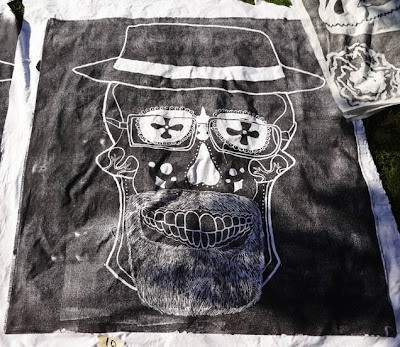Some school classes, BSU students and local artists have been carving for weeks on 4' x 8' (or 4' x 4') pieces of MDF board. A friend and I worked on one 4' x 8' board together. She came up with the idea and design. I helped tweak the design a little and we both did lots of carving.
The theme for the prints was Dia de los Muertos (Day of the Dead). There will be a procession of the prints through downtown on Nov. 2 They also will be on display at the Historical Museum's annual Day of the the Dead celebration
Here is our board with Goodbye Kitty (as opposed to Hello Kitty) as we were just getting started on the carving. A huge thank you goes out to Amy Nack at Wingtip Press for helping us attain the board, letting us keep the board at her space and transporting the board to the museum. I'm not sure we would have participated without her help.
Marigold flowers are one of the symbols for Day of the Dead. The scent of the flower is suppose to help draw the deceased back to earth for the annual celebration. We integrated several of our own version of marigolds into the design.
On Saturday, we volunteers went to the museum early to set up. The printing was done on the road behind the village outside of the museum. When I arrived, the boards were leaning against buildings and fences everywhere. There were around 50 boards that needed to be printed three times each. We were told that we would need to print one every 9 minutes to get through them all that day.
It was very well planned and coordinated. There were two "inking" stations set up (two blocks were printed at once by the steam roller). Latex house paint was rolled on the boards by two teams of inkers. The blocks were printed on sheets, so there was a team of people laying down sheets on the printing area. Another team of guys were in charge of carrying the blocks from the inking station to the printing area and back again. Other people helped hang up or lay out the sheets on the grass once they were printed.
I helped with rolling the paint on the blocks. Once we got going, things went smoothly, we had a good rhythm and were able to get everything printed. Some of the school classes came to help with their prints and many people came by to watch. A DJ was there playing music and it was a great community event.
Here are some of the blocks lined up waiting to be printed. They already have color on them because the artists toned the boards to make it easier to see the design when carving.
In this picture you can see the two "inking" stations. There were mostly BSU students volunteering and just a few others, like me.
Here you can see the sheet laid out on the ground and the guys getting ready to flip the board face down onto the sheet (this is opposite of what you would normally do with a regular printing press).

Below, my friend, Cassandra, is driving the steam roller over the boards (under the carpet pad). There are two boards laid out. She drove over them once and then backed up over them again.
And some of the results!
Some of the sheets were donated by BSU (old ones they weren't going to use anymore), but artists were also asked to bring their own since there wasn't quite enough. We thought Goodbye Kitty really needed to have some pink sheets and we were able to find some at the thrift stores.
This sheet also had pink flowers.
If you missed the event, you can see the prints at the Idaho State Historical Museum. It was a fun event and the biggest piece of art I have made to date. All the prints turned out really well.












2 comments:
Lisa, how difficult is it to carve MDF board? Looks like a great way to do a large print.
These are wonderful.
It wasn't any harder to carve than a regular woodblock if you have the right tools.
Post a Comment